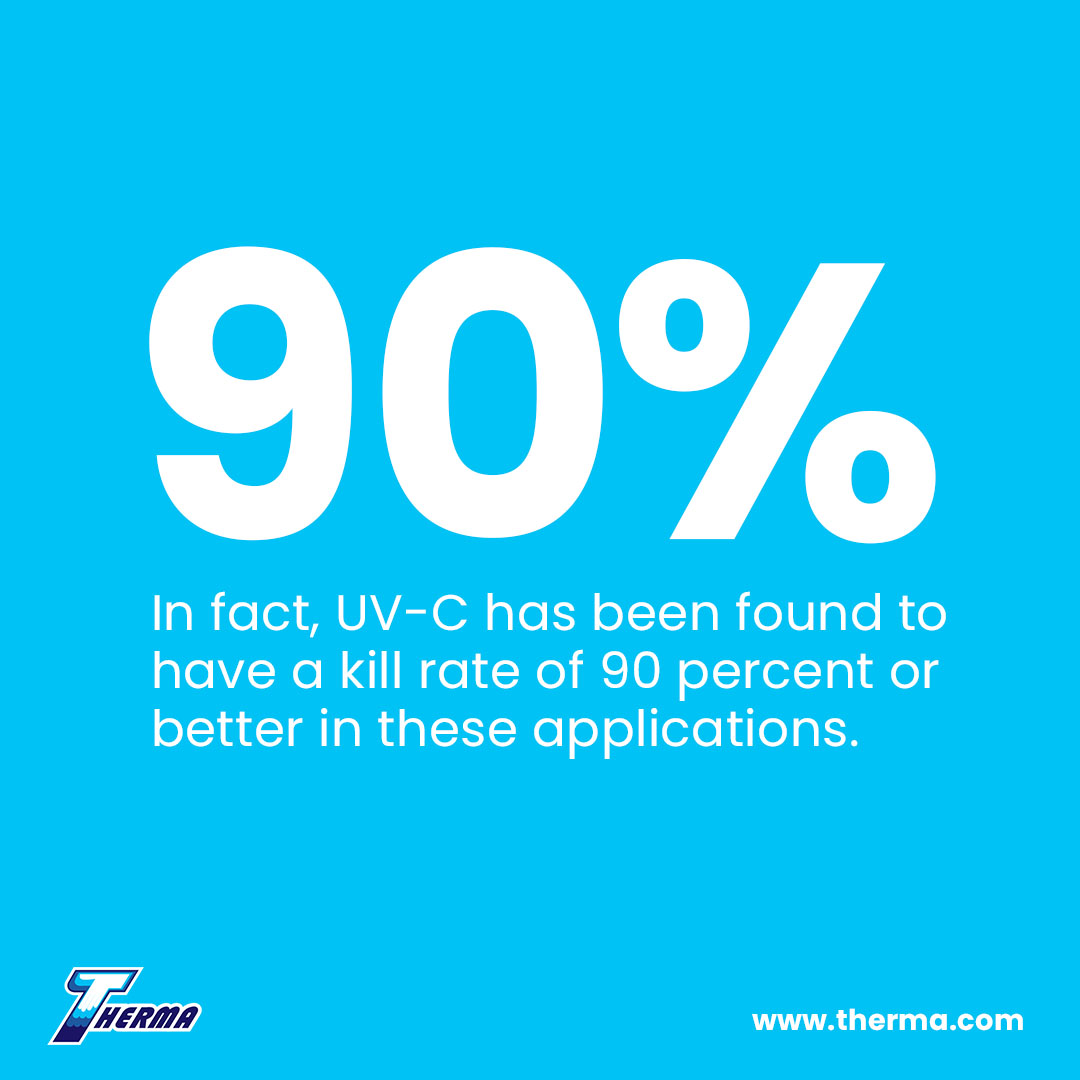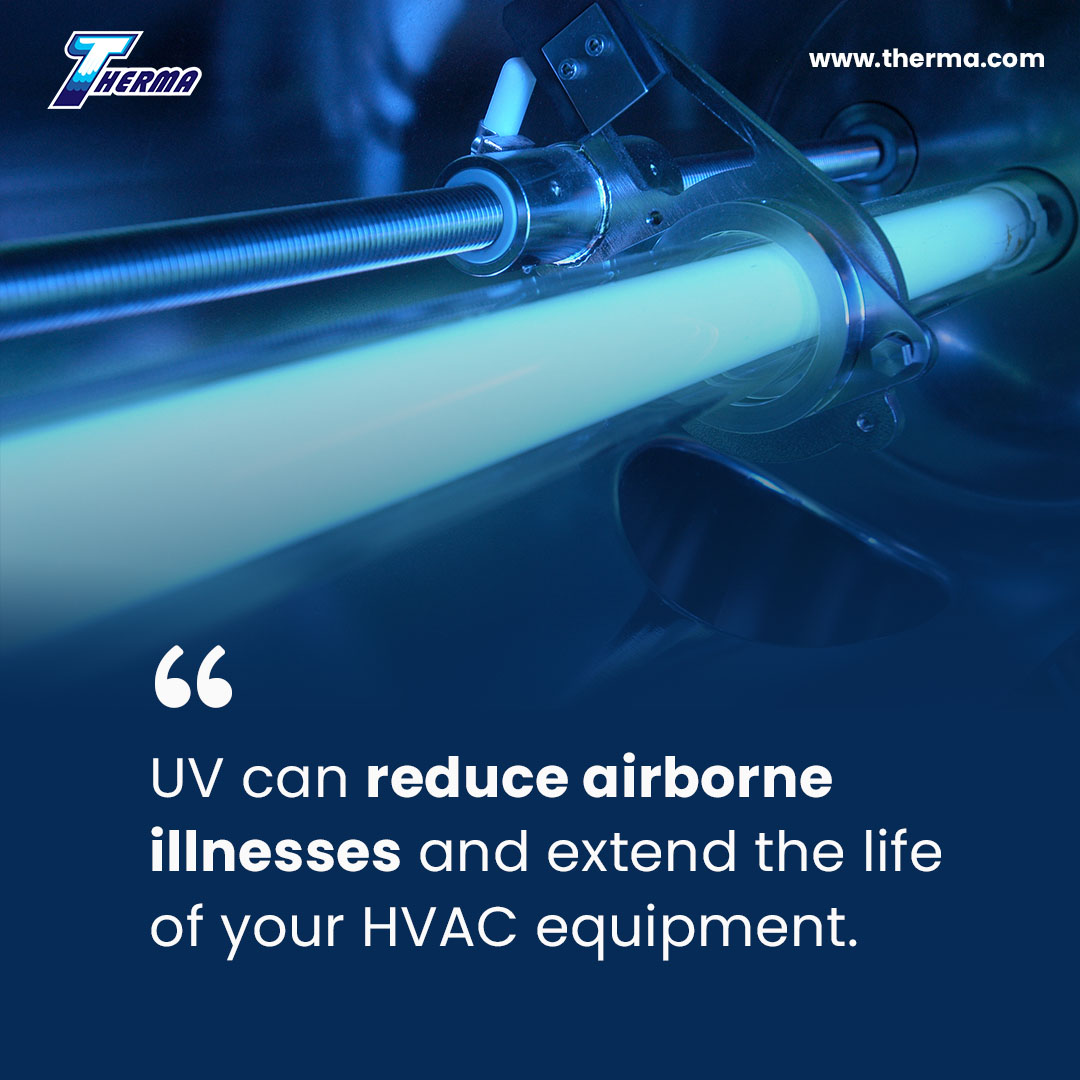For decades, filtration, ventilation and humidity control have served as the foundation of an efficacious commercial indoor air quality (IAQ) program. However, none of these strategies can effectively contain biological contaminants such as bacteria, viruses, mold, and fungi. Installing a UV light into a commercial HVAC system offers an additional level of protection against hazardous airborne pollutants. However, UV lights are active systems, so it’s important to have them installed, maintained and serviced by a skilled and experienced commercial HVAC professional.
Understanding Ultraviolet Light
Ultraviolet, or UV, is in the electromagnetic spectrum at a wavelength between 400 and 10 nanometers, which resides between visible light and X-rays. [1] UV-C light (100-290nm) can be used to kill microorganisms that cause infection and disease by disrupting the nucleic acids inside their cell structure. Here are some of the most common organisms UV light eradicates: [2]
- Rhinoviruses (common colds)
- Infectious Hepatitis
- Influenza (flu)
- Aspergillus flavus (common mold)
- Streptococcal pharyngitis (strep throat)
- Salmonella enteritidis
- Staphylococcus aureus (MRSA infections)
- Penicillium chrysogenum (common mold)
- Mycobacterium tuberculosis
How UV Lights Work in Commercial HVAC Systems
UV light exposure causes irreparable damage to the cellular structure of an organism by breaking down its molecular bonds and damaging its DNA. As a result, the organism can no longer reproduce and is rendered inert if it enters a human body. UV lights installed inside of a commercial duct system provide an additional layer of purification for the indoor environment. As the HVAC equipment operates, the entire content of the air is exposed to the UV light, which destroys the microorganisms before they enter the occupied area.
While UV lights are often installed inside the duct network, many products are designed for installation directly into the coil system. This helps keep the coil free from mold, fungi and other biologicals that can degrade the performance of the equipment as well as negatively impact indoor air quality. In both duct mounted and coil mounted applications, UV light must make direct contact with the organism to establish a high “kill” rate. While it only takes a few seconds of direct exposure to eliminate most contaminants, partial exposure may yield unsatisfactory results.
The Benefits of UVGI Light Disinfection
UV lamps are a proven technology used in commercial settings since the 1930s to eliminate biological organisms in locations where cleanliness is paramount. Hospitals and medical facilities benefit from HVAC UVGI light installation by reducing the spread of infectious diseases and air borne contaminants. [3] Food processing facilities require sanitary conditions for the preparation and handling of food. In high-tech manufacturing, UV lights help maintain clean room standards for environments that are virtually sterile and free of microorganisms. In fact, UV-C has been found to have a kill rate of 90 percent or better in these applications.[4]

A commercial building that’s accessible to hundreds of people every day creates conditions conducive to the spread of disease through substandard air transference. In conjunction with other IAQ products, UV lights can reduce the spread of flu, colds and allergy irritants. [5]
Commercial UV lamp installation provides a variety of critical benefits:
- Reduced incidence of lung-related disease and symptoms
- Lower chance of spreading airborne disease
- Eliminates the need for harsh cleaning agents for dirty coils
- Lower risk of mold or fungi growth on critical components inside the HVAC system
- Reduced growth of biological material inside the air handler and condensate drain pans
- Eliminates foul odors for fresher smelling indoor air
- Longer equipment life
- Lower HVAC maintenance and repair costs
Other Considerations
It’s important to note that UV light is just one component in a comprehensive indoor air quality strategy. Effective filtration must still be used to eliminate airborne dust, and mechanical air exchange should be employed to remove stale indoor air and replace it with fresh air from outdoors.
When purchasing a UV system, consider the following:
- Confirm the lamp has a UV wavelength between 260-265nm, which is the most effective intensity for destroying microbes.
- Only hire a commercial HVAC contractor with experience installing UV units. Improper installation may result in substandard performance and could cause serious potential physical injury.
- Consider installing a multi-bulb unit to eradicate organisms in the ductwork and around the coil.
- Glass bulbs provide greater intensity while plastic bulbs last longer and are abuse resistant. Depending on the model, most bulbs must be replaced every three years.
Incorporate UV Lamps into Your IAQ Strategy
The increasing popularity of UV lamps is driven by a desire to provide a safer environment for clients, vendors, patients, and employees. As part of a complete IAQ system, UV can reduce airborne illnesses and extend the life of your HVAC equipment. Therma professionals can evaluate your current HVAC system configuration and create an IAQ strategy that will help keep the air in your facility cleaner and healthier.
By William Busse
William Busse has more than 30 years experience in the construction industry in sales, contracting, distribution and manufacturing. He has an extensive background in the mechanical contracting industry, largely from the distribution and manufacturing sides of the business. He has had deep involvement with a variety of large-scale commercial/industrial mechanical contractors, particularly related to value engineering. This includes process piping, high-pressure steam, cryogenics, thermal insulation, and commercial/industrial HVAC.

Sources:
- http://solar-center.stanford.edu/about/uvlight.html
- https://ultraviolet.com/microorganisms-deactivated/
- http://hospitalnews.com/ultraviolet-hvac-keys-reducing-hospital-acquired-infections/
- https://www.achrnews.com/articles/131877-ashrae-validates-effectiveness-of-uv-c
- https://www.webmd.com/cold-and-flu/news/20180212/can-uv-light-be-used-to-kill-airborne-flu-virus-#1
- https://c.ymcdn.com/sites/www.aafame.org/resource/resmgr/docs/sanuvox_ashrae_july_2014.pdf
- https://www.esmagazine.com/ext/resources/ES/Home/Files/PDFs/sanuvox-original.pdf







